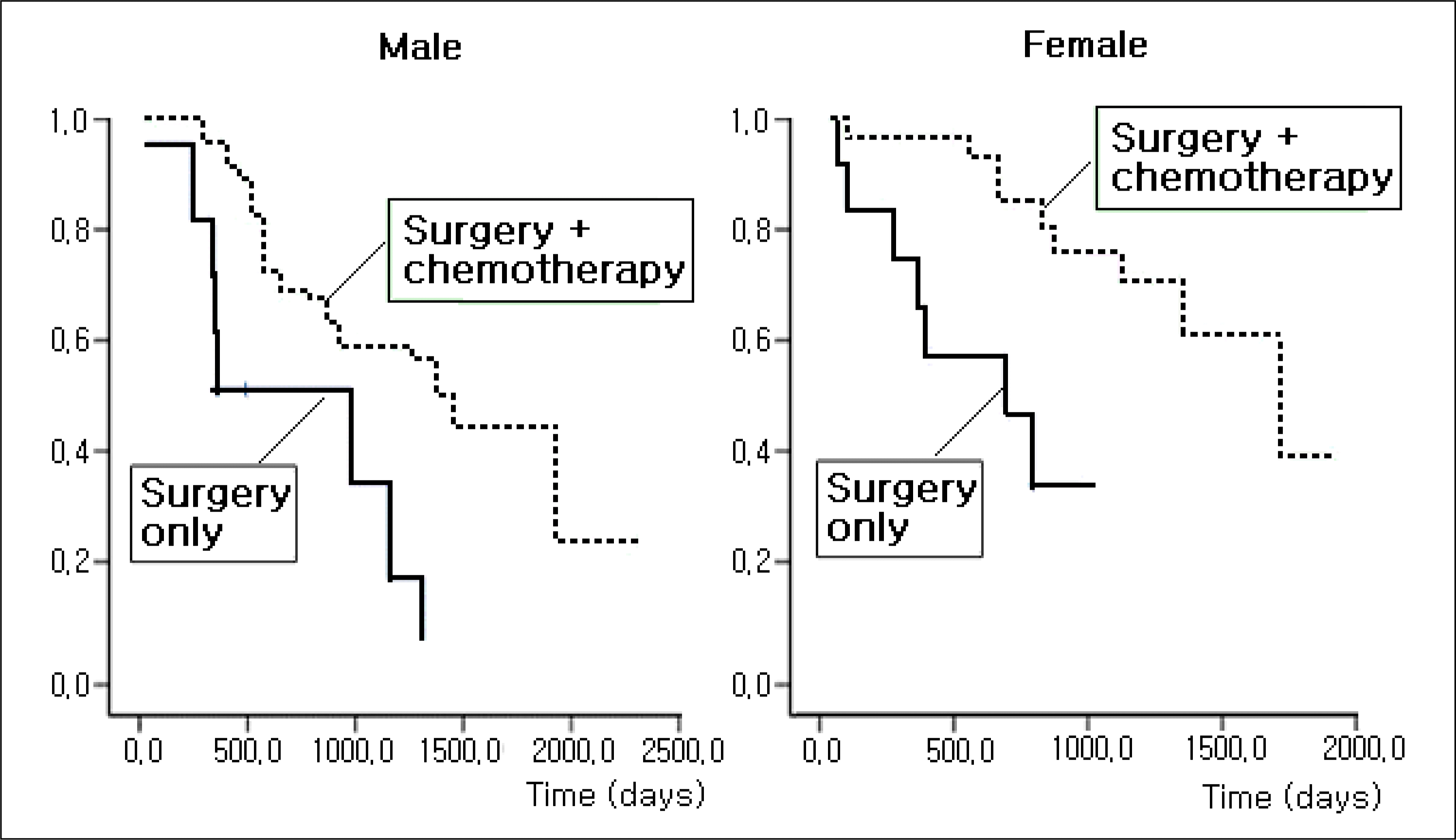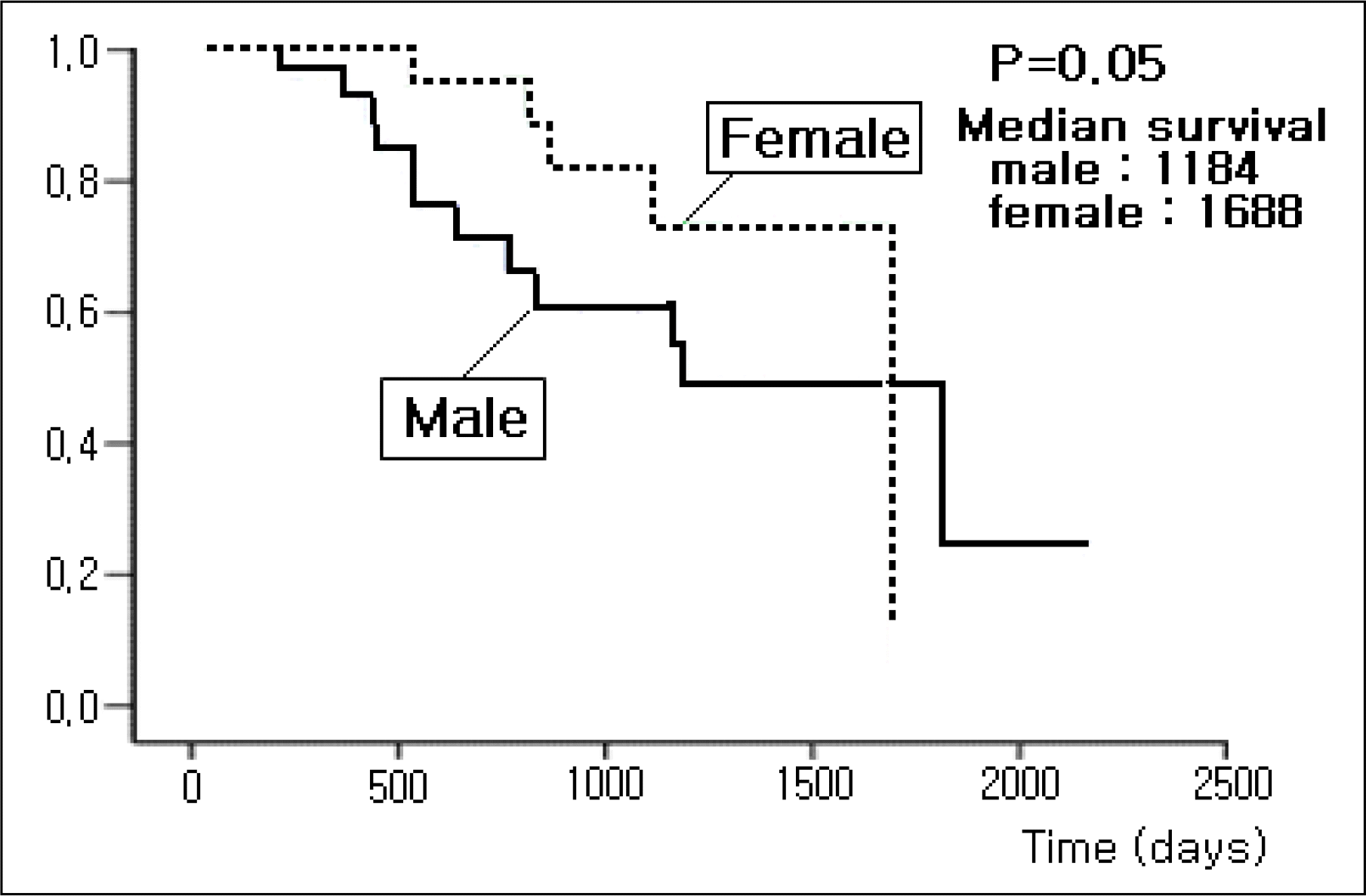Abstract
Background:
The incidence of adenocarcinoma of the lung has been increasing worldwide, and it has been generally been accepted to be relatively unrelated to smoking with a female preponderance. The aim of this study was to examine the gender-related pathological and survival differences in patients with an adenocarcinoma of the lung.
Material and Method:
A retrospective review of the clinical information of patients diagnosed with an adenocarcinoma of the lung at Kosin Medical Center from January 1999 to September 2005 was performed. The patient's demographics (age, gender), smoking history, stage, serum tumor marker, pathology classification, EGFR mutation, K-ras mutation, treatment methods, and survival time were analyzed.
Result:
Of the 438 patients, 179 (40.9%) were female. The median age at the diagnosis was 58 years for females and 59 years for males. However, 25.8% of women and only 17.7% of men were under 50 years of age (p=0.02). The distribution of the disease stage was similar in both men and women. The bronchioloalveolar carcinoma component was diagnosed more often in women (11.2%) than in men (5.0%). The overall survival rate was higher in women than in men (p=0.01), and women had a superior therapeutic response to a combined treatment of surgery and chemotherapy.
Conclusion:
This study showed significant genders differences in terms of the smoking history, bronchioloalveolar carcinoma component, overall survival, and survival after combined treatment of surgery and chemotherapy. Therefore, gender differences should be considered when diagnosing and treating adenocarcinomas of the lung.
REFERENCES
1.Fiore MC., Novotny TE., Pierce JP., Hatziandreu EJ., Patel KM., Davis RM. Trends in cigarette smoking in United States: the changing influence of gender and race. JAMA. 1989. 261:49–55.
2.Henschke CI., Miettinen OS. Women's susceptibility to tobacco carcinogens. Lung Cancer. 2004. 43:1–5.

3.McDuffie HH., Klaassen DJ., Dosman JA. Female-male differences in patients with primary lung cancer. Cancer. 1987. 59:1825–30.

4.Brownson RC., Chang JC., Davis JR. Gender and histologic type variations in smoking-related risk of lung cancer. Epidemiology. 1992. 3:61–4.

5.Travis WD., Lubin J., Ries L., Devesa S. United States lung carcinoma incidence trends: declining for most histologic types among males, increasing among females. Cancer. 1996. 77:2464–70.

6.Radzikowska E., Glaz P., Roszkowski K. Lung cancer in women: age, smoking, histology, performance status, stage, initial treatment and survival. Population based study of 20561 cases. Ann Oncol. 2002. 13:1087–93.
7.Osann KE., Anton-Culver H., Kurosaki T., Taylor T. Sex differences in lung-cancer risk associated with cigarette smoking. Int J Cancer. 1993. 54:44–8.

8.Barsky SH., Cameron R., Osann KE., Tomita D., Holmes EC. Rising incidence of bronchioloalveolar lung carcinoma and its unique clinicopathologic features. Cancer. 1994. 73:1163–70.

9.Albertine JH., Steiner RM., Radack DM., Golding DM., Peterson D., Cohn HE, et al. Analysis of cell type and radiographic presentation as predictors of the clinical course of patients with bronchioloalveolar cell carcinoma. Chest. 1998. 113:997–1006.

10.Thun MJ., Lally CA., Flannery JT., Calle EE., Flanders WD., Heath CW Jr. Cigarette smoking and changes in the histopathology of lung cancer. J Natl Cancer Inst. 1997. 89:1580–6.

11.Muscat JE., Wynder EL. Lung cancer pathology in smokers, ex-smokers and never smokers. Cancer Lett. 1995. 88:1–5.

12.Fukuoka M., Yano S., Giaccone G., Tamura T., Nakagawa K., Douillard JY, et al. Multi-institutional randomized phase II trial of gefitinib for previously treated patients with advanced non-small-cell lung cancer (The IDEAL 1 Trial). J Clin Oncol. 2003. 21:2237–46.
13.de Perrot M., Licker M., Bouchardy C., Usel M., Robert J., Spiliopoulos A. Sex differences in presentation, management, and prognosis of patients with non-small cell lung carcinoma. J Thorac Cardiovasc Surg. 2000. 119:21–6.

14.Etzel CJ., Lu M., Merriman K., Liu M., Vaporciyan A., Spitz MR. An epidemiologic study of early onset lung cancer. Lung cancer. 2006. 52:129–34.

15.Fu JB., Kau TY., Severson RK., Kalemkerian GP. Lung cancer in women: analysis of the national Surveillance, Epidemiology, and End Results database. Chest. 2005. 127:768–77.
16.O'Connell JP., Kris MG., Gralla RJ., Groshen S., Trust A., Fiore JJ, et al. Frequency and prognostic importance of pretreatment clinical characteristics in patients with advanced non-small-cell lung cancer treated with combination chemotherapy. J Clin Oncol. 1986. 4:1604–14.
17.Minami H., Yoshimura M., Miyamoto Y., Matsuoka H., Tsubota N. Lung cancer in women: sex-associated differences in survival of patients undergoing resection for lung cancer. Chest. 2000. 118:1603–9.
18.Alexiou C., Onyeaka CV., Beggs D., Akar R., Beggs L., Salama FD, et al. Do women live longer following lung resection for carcinoma? Eur J Cardiothorac Surg. 2002. 21:319–25.

19.Ferguson MK., Wang J., Hoffman PC., Haraf DJ., Olak J., Masters GA, et al. Sex-associated differences in survival of patients undergoing resection for lung cancer. Ann Thorac Surg. 2000. 69:245–50.

20.Risch HA., Howe GR., Jain M., Burch JD., Holowaty EJ., Miller AB. Are female smokers at higher risk for lung cancer than male smokers? A case control analysis by histologic type. Am J Epidemiol. 1993. 138:281–93.
21.Kure EH., Ryberg D., Hewer A., Phillips DH., Skaug V., Baera R, et al. p53 mutations in lung tumours: relationship to gender and lung DNA adduct levels. Carcinogenesis. 1996. 17:2201–5.
22.Ryberg D., Hewer A., Phillips DH., Haugen A. Different susceptibility to smoking-induced DNA damage among male and female lung cancer patients. Cancer Res. 1994. 54:5801–3.
23.Mollerup S., Ryberg D., Hewer A., Phillips DH., Haugen A. Sex differences in lung CYP1A1 expression and DNA adduct levels among lung cancer patients. Cancer Res. 1999. 59:3317–20.
24.Nelson HH., Christiani DC., Mark EJ., Wiencke JK., Wain JC., Kelsey KT. Implications and prognostic value of K-ras mutation for early-stage lung cancer in women. J Natl Cancer Inst. 1999. 91:2032–8.

25.Caracta CF., Powell C., Brody JS. Estrogen receptor status of lung cancer cell lines [abstract]. Am J Respir Crit Care Med. 1999. 159:A204.
26.Denissenko MF., Pao A., Tang M., Pfeifer GP. Preferential formation of benzo [⍺] pyrene adducts at lung cancer mutational hotspots in p53. Science. 1996. 274:430–2.
27.Tredaniel J., Boffetta P., Saracci R., Hirsch A. Exposure to environmental tobacco smoke and risk of lung cancer: the epidemiological evidence. Eur Respir J. 1994. 7:1877–88.

28.Schwartz AG., Yang P., Swanson GM. Familial risk of lung cancer among nonsmokers and their relatives. Am J Epidemiol. 1996. 144:554–62.

29.Ooi WL., Elston RC., Chen VW., Bailey-Wilson JE., Rothschild H. Increased familial risk for lung cancer. J Natl Cancer Inst. 1986. 76:217–22.
30.Ko YC., Cheng LS., Lee CH., Huang JJ., Huang MS., Kao EL, et al. Chinese food cooking and lung cancer in women nonsmokers. Am J Epidemiol. 2000. 151:140–7.

32.Cheng YW., Chiou HL., Sheu GT., Hsieh LL., Chen JT., Chen CY, et al. The association of human papillomavirus 16/18 infection with lung cancer among nonsmoking Taiwanese women. Cancer Res. 2001. 61:2799–803.
33.Mayne ST., Buenconsejo J., Janerich DT. Previous lung disease and risk of lung cancer among men and women nonsmokers. Am J Epidemiol. 1999. 149:13–20.

34.Fasco MJ., Hurteau GJ., Spivack SD. Gender-dependent expression of alpha and beta estrogen receptors in human nontumor and tumor lung tissue. Mol Cell Endocrinol. 2002. 188:125–40.

35.Omoto Y., Kobayashi Y., Nishida K., Tsuchiya E., Eguchi H., Nakagawa K, et al. Expression, function, and clinical implications of estrogen receptor ßin human lung cancers. Biochem Biophys Res Commun. 2001. 285:340–7.
36.Taioli E., Wynder EL. Re: Endocrine factors and adenocarcinoma of the lung in women. J Natl Cancer Inst. 1994. 86:869–70.

38.Yoshino I., Baba H., Fukuyama S., Kameyama T., Shikada Y., Tomiyasu M, et al. A time trend of profile and surgical results in 1123 patients with non-small cell lung cancer. Surgery. 2002. 131:S242–8.

39.Hirsch F., Veve R., Varella-Garcia M. Evaluation of HER-2/neu expression on lung tumors by immunohistochemistry and fluorescence in situ hybridization [abstract]. Proc Am Soc Clin Oncol. 2000. 19:486A.
40.Rachwal WJ., Bongiorno PF., Orringer MB., Whyte RI., Ethier SP., Beer DG. Expression and activation of erb-2 and epidermal growth factor receptor in lung adenocarcinomas. Br J Cancer. 1995. 72:56–64.
41.Wei Q., Cheng L., Amos CI., Wang LE., Guo Z., Hong WK, et al. Repair of tobacco carcinogen-induced DNA adducts and lung cancer risk: a molecular epidemiological study. J Natl Cancer Inst. 2000. 92:1764–72.
42.Spitz MR., Wei Q., Dong Q., Amos CI., Wu X. Genetic susceptibility to lung cancer: the role of DNA damage and repair. Cancer Epidemiol Biomarkers Prev. 2003. 12:689–98.
43.Lord RV., Brabender J., Gandara D. Low ERCC1 expression correlates with prolonged survival after cisplatin plus gemcitabine chemotherapy in non-small cell lung cancer. Clin Cancer Res. 2002. 8:2286–91.
44.Werner-Wasik M., Scott C., Cox JD., Sause WT., Byhardt RW., Asbell S, et al. Recursive partitioning analysis of 1999 Radiation Therapy Oncology Group (RTOG) patients with locally-advanced non-small cell lung cancer (LA-NSCLC): identification of five groups with different survival. Int J Radiat Oncol Biol Phys. 2000. 48:1475–82.
45.Albain KS., Crowley JJ., LeBlanc M., Livingston RB. Survival determinants in extensive-stage non-small cell lung cancer: the Southwest Oncology Group experience. J Clin Oncol. 1991. 9:1618–26.
Figure 1.
Kaplan-Meier curve of overall survival of patients according to the treatment modality between the gender

Figure 2.
Kaplan-Meier curve of the survival between male and female with combined therapy of surgery and chemotherapy

Table 1.
Baseline Characteristics
| Patient Characteristics | Female (n=179) | Male (n=259) | p value |
|---|---|---|---|
| Gender(%) | 40.9 | 59.1 | 0.7 |
| Mean age(years) | 58(30~85) | 59(32~81) | 0.2 |
| Smoking(%) | 18 | 86 | 0.000 |
| Median survival time(days) | 823 | 639 | 0.01 |
Table 2.
The prevalence of adenocarcinoma according to the age
| age | Female | Male | p value | ||
|---|---|---|---|---|---|
| Number | Frequency(%) | Number | Frequency(%) | ||
| ≤ 30 | 1 | 0.6 | 0 | 0 | |
| 31-40 | 10 | 6.2 | 18 | 6.9 | |
| 41-50 | 35 | 25.8 | 28 | 17.7 | 0.02★ |
| 51-60 | 60 | 59.3 | 88 | 51.7 | |
| 61-70 | 47 | 85.6 | 93 | 87.6 | |
| ≥ 71 | 26 | 100 | 32 | 100 | |
| Total | 179 | 259 | |||
Table 3.
Mean values and standard deviation of laboratory results of patients
| Female | Male | p value | |
|---|---|---|---|
| WBC★(109/L) | 8.1±3.7 | 9.0±4.1 | 0.264 |
| Hb†(g/dl) | 11.9±1.3 | 12.7±1.6 | 0.03 |
| PLT‡(109/L) | 306±92 | 288±110 | 0.054 |
| ALP§(U/L) | 178.6±71.4 | 197.6±127.2 | 0.113 |
| LDH∏(U/L) | 342.1±178.8 | 360.4±141.0 | 0.766 |
| CEA¶(ng/ml) | 222.3±858.6 | 168.8±530.7 | 0.084 |
| NSE★★(ng/ml) | 13.3±17.4 | 12.8±10.2 | 0.692 |




 PDF
PDF ePub
ePub Citation
Citation Print
Print


 XML Download
XML Download